Israel has cast the deaths of civilians in the
Gaza Strip as a regrettable but unavoidable part of modern conflict, pointing
to the heavy human toll from military campaigns the United States itself once
waged in Iraq and Syria.
اضافة اعلان
But a review of
past conflicts and interviews with casualty and weapons experts suggest that
Israel’s assault is different.
Conservative casualty figures
While wartime death tolls will never be exact,
experts say that even a conservative reading of the casualty figures reported
from Gaza shows that the pace of death during Israel’s campaign has few
precedents in this century.
People are being killed in Gaza more quickly
than Iraq, Syria, and Afghanistan
People are being killed in Gaza more quickly,
they say, than in even the deadliest moments of US-led attacks in Iraq, Syria
and Afghanistan, which were themselves widely criticized by human rights
groups.
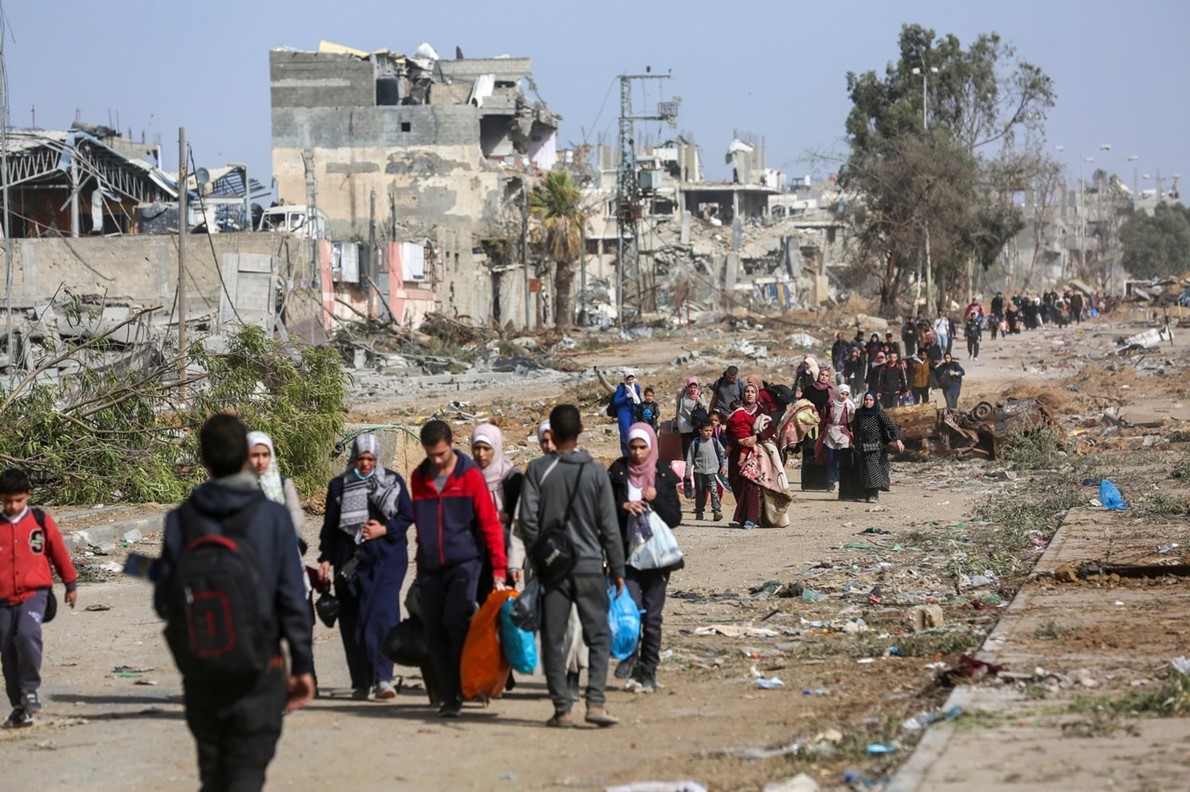 Displaced Palestinians from the north of the Gaza Strip on
their way south, in the presence of Israeli military, on Nov. 26, 2023.
Displaced Palestinians from the north of the Gaza Strip on
their way south, in the presence of Israeli military, on Nov. 26, 2023.
Precise comparisons of war dead are
impossible, but conflict-casualty experts have been taken aback at just how
many people have been reported killed in Gaza — most of them women and children
— and how rapidly.
15,000 targets before ceasefire
It is not just the scale of the strikes;
Israel said it had engaged more than 15,000 targets before reaching a brief
cease-fire in recent days. It is also the nature of the weaponry itself.
Israel’s liberal use of weapons
Israel’s liberal use of very large weapons in
dense urban areas, including US-made 1 tonne bombs that can flatten an
apartment tower, is surprising, some experts say.
“It is beyond anything that I’ve seen in my
career,” said Marc Garlasco, a military adviser for the Dutch organization PAX
and a former senior intelligence analyst at the Pentagon. To find a historical
comparison for so many large bombs in such a small area, he said, we may “have
to go back to Vietnam or the Second World War.”
In fighting during this century, by contrast,
U.S. military officials often believed that the most common US aerial bomb — a
500-pound weapon — was far too large for most targets when battling the Islamic
State group in urban areas like Mosul, Iraq, and Raqqa, Syria.
The Israeli military points out that Gaza
presents a battlefield like few others. It is small and dense, with civilians
living next to and even on top of Hamas combatants who rely on tunnel networks
to shield themselves and their weapons, putting residents directly in the line
of fire, the military says.
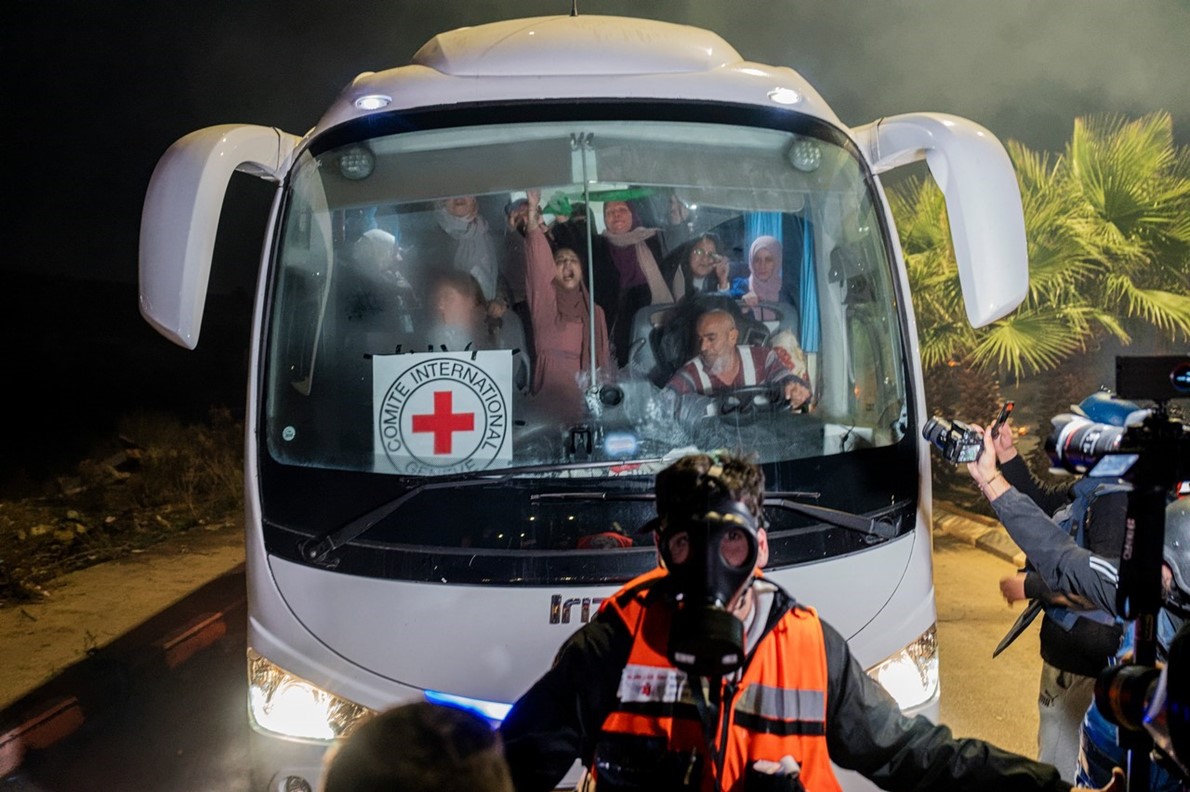 A bus
operated by the International Committee of the Red Cross carries freed
Palestinian prisoners and detainees from the Israeli Ofer military prison near
Ramallah in the West Bank, Nov. 24, 2023. Some two dozen hostages held in Gaza,
including Israelis and Thai nationals, were released from captivity on Friday,
Egyptian and Qatari officials said, and Israel confirmed it had freed 39
Palestinian prisoners and detainees, completing the first exchange laid out by
a deal between Israel and Hamas for a temporary cease-fire.
A bus
operated by the International Committee of the Red Cross carries freed
Palestinian prisoners and detainees from the Israeli Ofer military prison near
Ramallah in the West Bank, Nov. 24, 2023. Some two dozen hostages held in Gaza,
including Israelis and Thai nationals, were released from captivity on Friday,
Egyptian and Qatari officials said, and Israel confirmed it had freed 39
Palestinian prisoners and detainees, completing the first exchange laid out by
a deal between Israel and Hamas for a temporary cease-fire.
Given these underground networks — which the
military says enabled Hamas to wage its deadly attacks on Oct. 7 — Israeli
forces say they use the “smallest available ordnance” to achieve their
strategic objectives and cause the “minimal adverse effect on civilians.”
Civilian casualties are hard to calculate
Civilian casualties are notoriously hard to
calculate, and officials in the Hamas-run Gaza Strip do not separate the deaths
of civilians and combatants.
Researchers point instead to the roughly
10,000 women and children reported killed in Gaza as an approximate — though
conservative — measure of civilian deaths in the territory. International
officials and experts familiar with the way figures are compiled by health
officials in Gaza say the overall numbers are generally reliable.
The Israeli military acknowledged that
children, women and older people have been killed in Gaza but said the death
toll reported in Gaza could not be trusted because the territory is run by
Hamas. The military did not provide a count of its own but said that civilians
“are not the target” of its campaign.
“We do a lot in order to prevent and, where
possible, minimize the killing or wounding of civilians,” said Lt. Col.
Jonathan Conricus, an Israeli military spokesperson. “We focus on Hamas.”
Still, researchers say the pace of deaths
reported in Gaza during the Israeli bombardment has been exceptionally high.
More than twice as many women and children
have already been reported killed in Gaza than in Ukraine after almost two
years of Russian attacks, according to United Nations estimates.
More women and children have been reported
killed in Gaza in less than two months than the roughly 7,700 civilians
documented as killed by US forces and their international allies in the entire
first year of the invasion of Iraq in 2003, according to estimates from Iraq
Body Count, an independent British research group.
The number of women and children reported
killed in Gaza since the Israeli campaign began last month has already started
to approach the roughly 12,400 civilians documented to have been killed by the
United States and its allies in Afghanistan during nearly 20 years of war,
according to Neta Crawford, co-director of Brown University’s Costs of War
Project.
These comparisons are based on the thousands
of deaths directly attributed to U.S. coalition forces over decades in Iraq,
Syria, and Afghanistan. Far more people — hundreds of thousands in total — are
estimated to have been killed in these conflicts by other groups, including the
Syrian government and its allies, local militias, the Islamic State group, and
the Iraqi security forces.
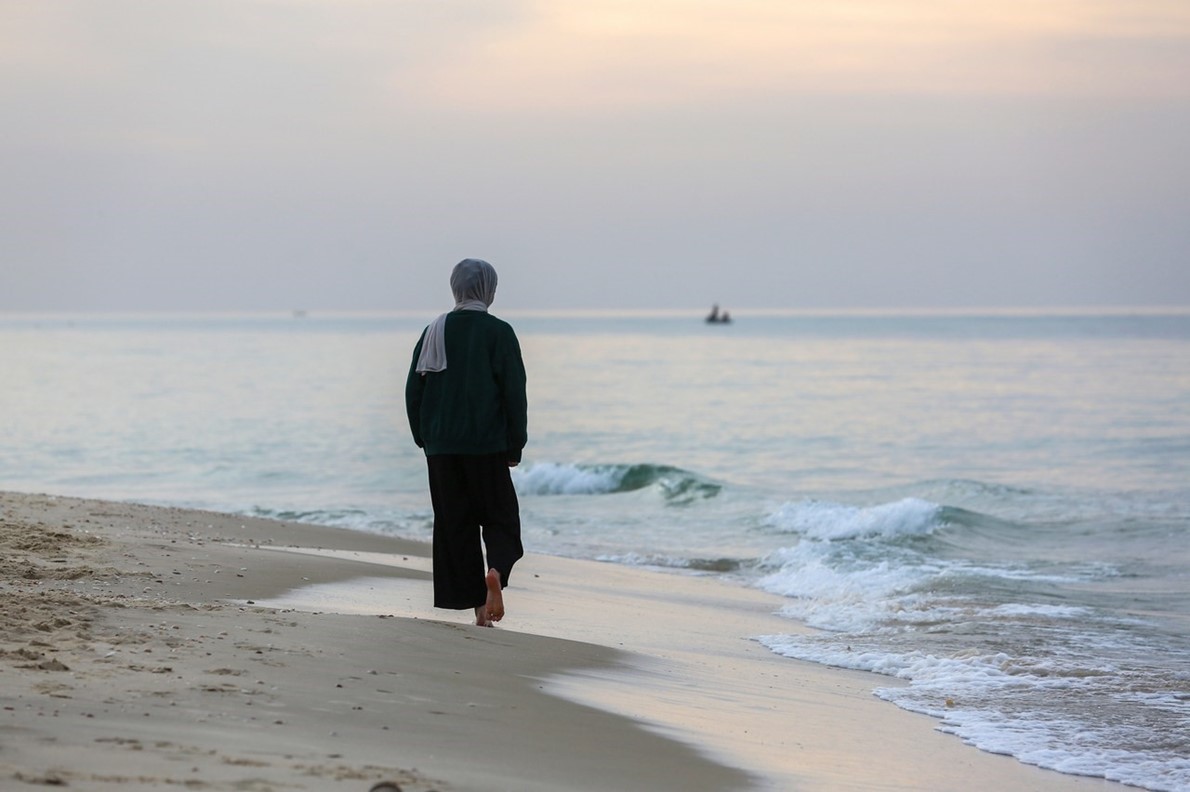 A
Palestinian woman on the beach in Khan Younis during the second day of a
temporary negotiated cease-fire, in the southern Gaza Strip on Nov. 25, 2023.
Israel is set to continue its invasion of Gaza after the truce, but future
hostage releases could pressure it to extend the cease-fire.
A
Palestinian woman on the beach in Khan Younis during the second day of a
temporary negotiated cease-fire, in the southern Gaza Strip on Nov. 25, 2023.
Israel is set to continue its invasion of Gaza after the truce, but future
hostage releases could pressure it to extend the cease-fire.
But while the overall death tolls in those
wars were larger, the number of people killed in Gaza “in a very short period
of time is higher than in other conflicts,” said Crawford, who has extensively
researched modern wars.
In the nine-month battle of Mosul, which
Israeli officials have cited as a comparison, an estimated total of 9,000 to
11,000 civilians were killed by all sides in the conflict, including many
thousands killed by the Islamic State group, The Associated Press found.
A similar number of women and children have
already been reported killed in Gaza in less than two months.
The bombs being used in Gaza are larger than
what the United States used when it was fighting the Islamic State group in
cities like Mosul and Raqqa and are more consistent with targeting underground
infrastructure like tunnels, said Brian Castner, a weapons investigator for
Amnesty International and a former explosive ordnance disposal officer in the
U.S. Air Force.
Not only is Gaza tiny when compared with
conflict zones like Iraq, Afghanistan or Ukraine, but the territory’s borders
have also been closed by Israel and Egypt, giving civilians few, if any, safe
places to flee.
More than 60,000 buildings have been damaged
or destroyed in Gaza, satellite analysis indicates, including about half of the
buildings in northern Gaza.
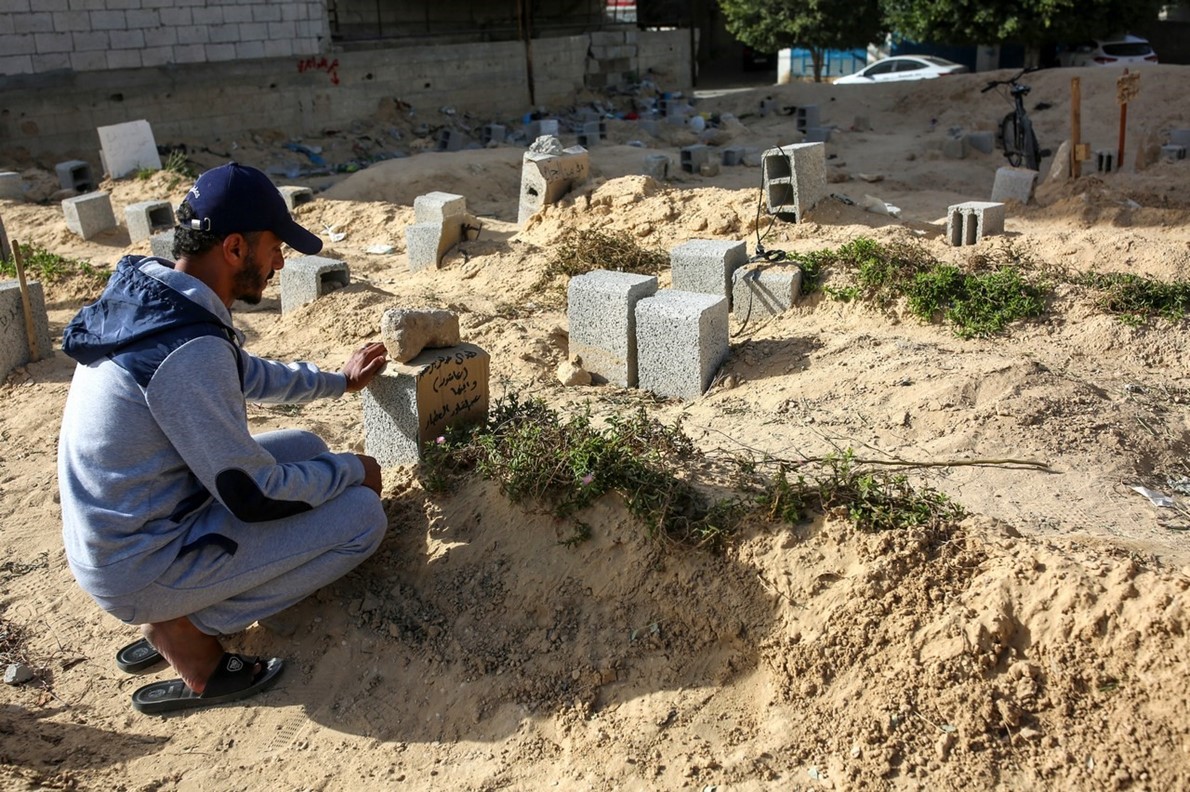 Palestinians
search for the graves of relatives buried during the truce period of the war
between Hamas and Israel in a cemetery in Deir al-Balah, Gaza, on Sunday, Nov.
26, 2023.
Palestinians
search for the graves of relatives buried during the truce period of the war
between Hamas and Israel in a cemetery in Deir al-Balah, Gaza, on Sunday, Nov.
26, 2023.
“They are using extremely large weapons in
extremely densely populated areas,” Castner said of Israeli forces. “It is the
worst possible combination of factors.”
A war ‘for our existence’
Israeli officials say their campaign is
focused on degrading Gaza’s military infrastructure, which is often built near
homes and civilian institutions — or buried underneath them.
“To get to that target,” Conricus said, the
military has to use “larger bombs with a higher yield.”
When an Israeli government spokesperson, Mark
Regev, was asked in an Oct. 24 interview with PBS about the pace of the
strikes, he said Israel was aiming for a shorter campaign than the United
States waged in Iraq and Syria.
“Hopefully, we get it done quicker,” Regev
said. “That’s one of our goals. But it could take longer than many Israelis
would hope because Hamas has been in power for 16 years.”
Israel has directed Gaza’s residents to
evacuate areas where the bombing campaign is especially concentrated, but it
has continued to strike other areas as well.
More broadly, Israeli officials say this is a
campaign on its own borders to wipe out Hamas, a group dedicated to Israel’s
destruction. “The war here is for our existence,” one Israeli war Cabinet
minister, Benny Gantz, told reporters Nov. 8.
After initially questioning the death toll in
Gaza, the Biden administration now concedes that the true figures for civilian
casualties maybe even worse.
Death toll could be higher
Barbara Leaf, the assistant secretary of state
for Near Eastern affairs, told a House committee this month that American
officials thought the civilian casualties were “very high, frankly, and it
could be that they are even higher than are being cited.”
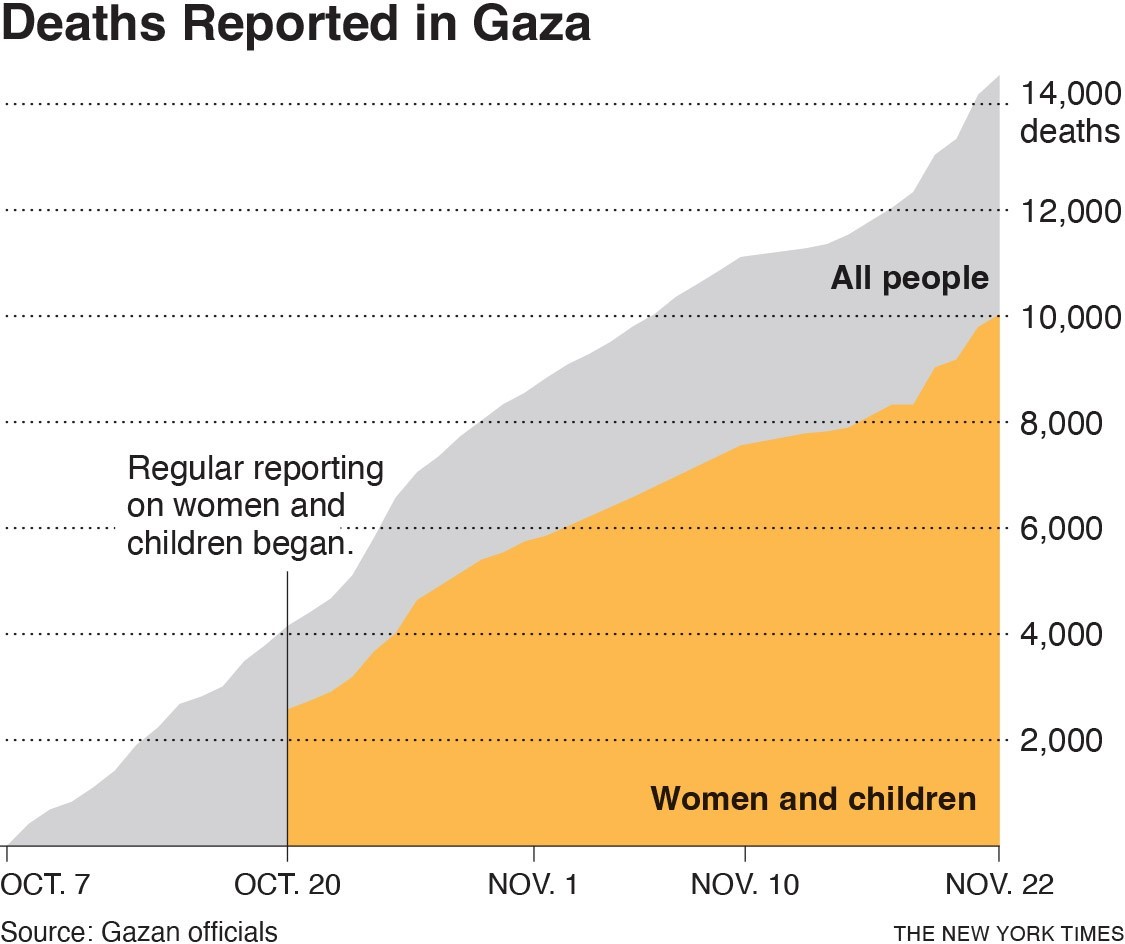 Even a
conservative reading of the casualty figures reported from Gaza shows that the
pace of death during Israel’s campaign has few precedents in this century.
Chart tracking deaths reported by Gazan authorities since Oct. 7
Even a
conservative reading of the casualty figures reported from Gaza shows that the
pace of death during Israel’s campaign has few precedents in this century.
Chart tracking deaths reported by Gazan authorities since Oct. 7
International experts who have worked with the
Gaza Health Ministry during this and other wars say that it gathers death
figures from hospitals and morgues across the enclave, which tally the dead and
report the names, ID numbers, and other details of people killed.
While the experts urged caution around public
statements about the specific number of people killed in a particular strike —
especially in the immediate aftermath of a blast — they said the aggregate
death tolls reported by the Gaza Health Ministry have typically proved to be
accurate.
In the last few weeks, recording the dead in
Gaza has become increasingly difficult in the chaos of the fighting as
hospitals come under direct fire, much of the health system ceases to function,
and other government officials have begun updating the number of killed instead
of the ministry. But even before those changes, the number of women and
children reported dead already outpaced other conflicts.
Women and children account for nearly 70
percent of all deaths reported in Gaza, even though most combatants are men —
an “extraordinary statistic,” Rick Brennan, the regional emergency director for
the World Health Organization’s Eastern Mediterranean office, said at an event
this month.
60 percent of the reported deaths in Gaza were
men
Normally, one would expect the opposite,
Brennan said. In past clashes between Israel and Hamas, for example, about 60
percent of the reported deaths in Gaza were men.
The Israeli military spokesperson, Conricus,
said the high percentage of women and children reported killed in Gaza is
another reason to mistrust the figures, adding that Israeli forces have warned
civilians of strikes in advance “where it is feasible.”
Beyond that, Israeli officials have pointed
not just to U.S. actions in Iraq and Syria but also to the conduct of America
and its allies during World War II.
In an address on Oct. 30, for example, Prime
Minister Benjamin Netanyahu cited the accidental bombing of a children’s
hospital by Britain’s Royal Air Force when it was targeting the Gestapo
headquarters in Copenhagen, Denmark, in 1945. During visits to Israel by
Secretary of State Antony Blinken, Israeli officials privately invoked the 1945
U.S. atomic bombings of Hiroshima and Nagasaki, which together killed more than
100,000 people.
Modern international laws of war were
developed largely in response to the atrocities of World War II.
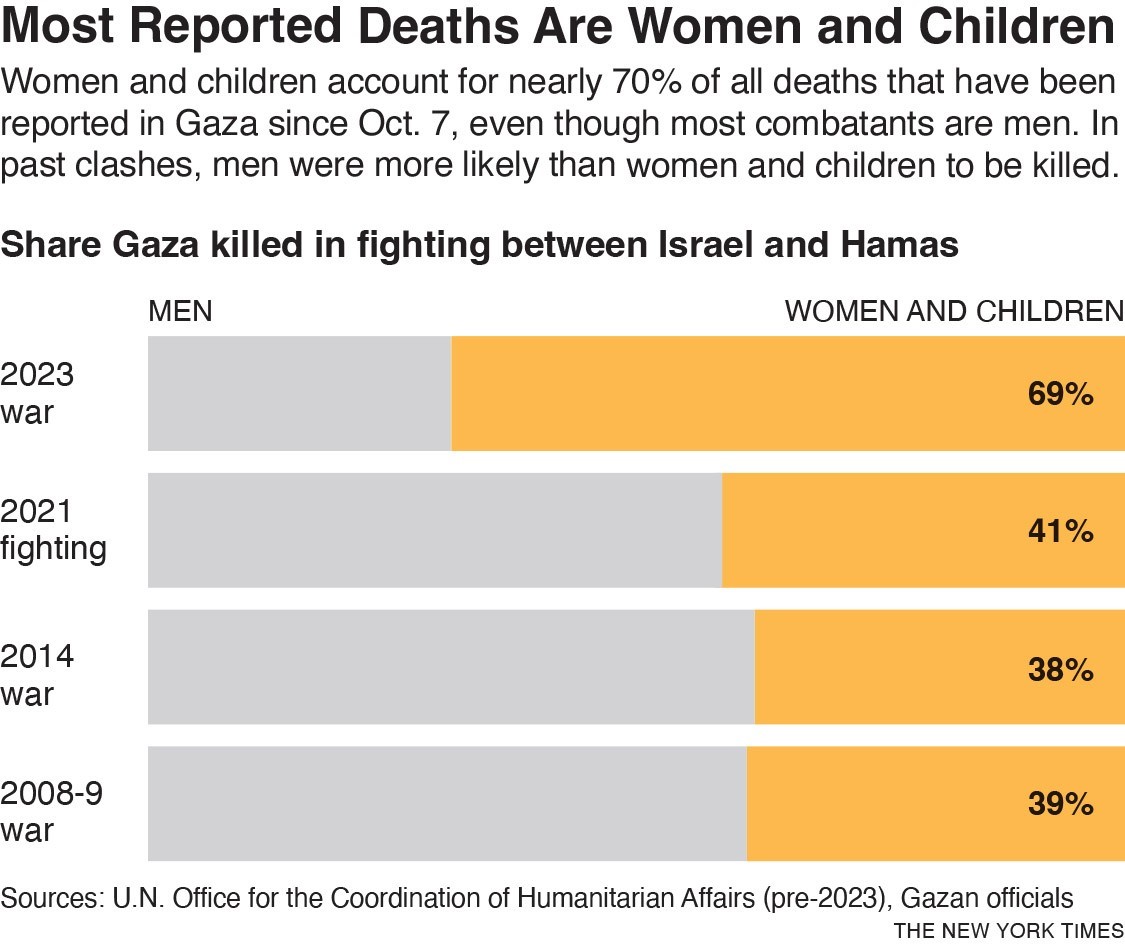
In 1949, the Geneva Conventions codified
protections for civilians during wartime. International law does not prohibit
civilian casualties, but it does say that militaries must not target civilians
directly or indiscriminately bomb civilian areas and that incidental harm and
the killing of civilians must not exceed the direct military advantage to be
gained.
Two one tonne bombs
In the first two weeks of the war, roughly 90
percent of the munitions Israel dropped in Gaza were satellite-guided bombs
weighing .5 to 1 tonne, according to a senior US military official who was not
authorized to discuss the matter publicly.
Those bombs are “really big,” said Garlasco,
the adviser for the PAX organization. Israel, he said, also has thousands of
smaller bombs from the United States that are designed to limit damage in dense
urban areas, but weapons experts say they have seen little evidence that they
are being used frequently.
In one documented case, Israel used at least
two one tonne bombs during an Oct. 31 airstrike on Jabalia, a densely populated
area just north of Gaza City, flattening buildings and creating impact craters
40 feet wide, according to an analysis of satellite images, photos and videos
by The New York Times. Airwars independently confirmed that at least 126
civilians were killed, more than half of them children.
The Israeli military said it had been
targeting a Hamas commander and fighters but acknowledged that it knew
civilians were present. Lt. Col. Richard Hecht, an Israeli military
spokesperson, said the casualties were a “tragedy of war.”
The barrage on Gaza has been intense
Every day, local journalists in Gaza report
strikes that hit private homes, some of which kill a dozen or more people as
families shelter together in tight quarters. On Oct. 19, Israel struck a Greek
Orthodox church where hundreds of Gaza’s small Christian community were
sheltering at dinnertime, killing 18 civilians, according to an investigation
by Amnesty International.
Conricus said that Hamas and its deliberate
strategy of embedding itself in — and underneath — the residents of Gaza are
“the main reason why there are civilian casualties.”
He said that hundreds of Israeli strikes on
Hamas have been diverted “because of the presence of civilians, children, women
and others who appear not to be connected to the fighting.”
Still, Castner of Amnesty International said
Israel appeared to be moving too quickly to reduce harm to civilians.
The United States itself has killed thousands
of civilians in years of aerial bombardments. But it generally tries to assess
civilians’ “pattern of life” before a strike, experts say. Analysts will watch
to see whether people go out to get food or water, for example, to determine
whether civilians are inside a building.
That kind of caution for every strike “is
literally not possible for the Israelis to do if they’re doing this many
strikes in as much time,” Castner said.
The long term
More children have been killed in Gaza since
the Israeli assault began than in the world’s major conflict zones combined —
across two dozen countries — during all of last year, even with the war in
Ukraine, according to U.N. tallies of verified child deaths in armed conflict.
When civilian areas are in the crosshairs, the
threat does not end when the bombing does, experts say. The destruction left in
the wake of war leaves people facing a struggle to survive long after the
conflict has ended. Decimated healthcare systems and compromised water supplies
alone can pose major public health risks, Crawford said.
“In every war, it’s like that,” she said. “But
this is a scale of immiseration over such a short period of time that it’s
really difficult to comprehend.”
Read more Region and World
Jordan News




